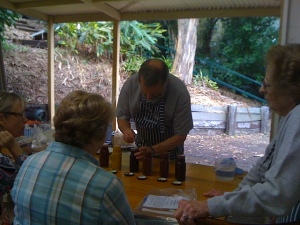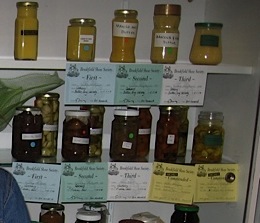Cookery judging myths and misconceptions
At every Show we get a lot of questions about the judging process in the Cookery. So here are some commonly asked questions including myths and misconceptions, and the answers you have been seeking!
Do the judges taste everything?
It is a persistent urban myth that the judges don’t taste all of the entries, and I get asked about this many times a year. In fact, the judges taste each and every entry, unless there is some reason not to, for example, there was mould present in the jam when opened (which happens occasionally). In fact once when we opened the lid on a preserve for judging, a cockroach flew out, but that’s another story!
With the preserves, the judge takes a small amount with a spoon from the side of the jar. With the cakes, unless the cake is in the decorated cakes section (these are judged on appearance only), the cake is cut in half, and a small wedge cut off one side, including the icing (if any). With biscuits, slices, small cakes and the like, the judge takes a small piece off one item for tasting.
What are the judges looking for?
The judge looks for colour, texture, uniformity (with small cakes or slices), and a great flavour which is appropriate to the item being judged. With cakes, the texture should be even throughout with no or very few trapped air bubbles or under or overcooking evident. If for example it is an orange cake section, the judge will be looking for a strong orange flavour, and good mouthfeel. A cake should be moist, but not overly so, and how moist will depend on the variety. The judge will be able to tell straight away that it has been properly cooked, and that quality ingredients have been used.
With preserves, the judge is again looking for flavour and texture. A proper set is important for jams, marmalades and jellies, but sometimes great flavour can overcome a preserve which may not be perfectly set. Ideally jellies and marmalades should be perfectly clear and glistening. Chutneys and relishes should be perfectly cooked, reflect their variety, and be of the appropriate texture so that they can be easily spooned out and are not too runny. Any overcooked preserves will be rejected by the judges, who can tell straight away by appearance and taste. The judge can also tell straight away (by taste and texture) if you have used an artificial jam setting product, and this is frowned up in Show work.
Is judging anonymous?
Absolutely! The judge never knows whose entry they have in front of them, as all judging is done anonymously.
Why do the same people win prizes year after year?
This does happen (but not as often as you think), and is not because the judge knows who entered the exhibit. The same people win prizes because they are very experienced, and know what the judges are looking for. You can get the same results by entering, learning from your mistakes, and knowing how to win prizes. This can be a lot quicker than you think!




Recent Comments